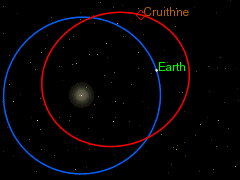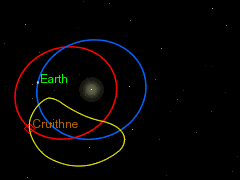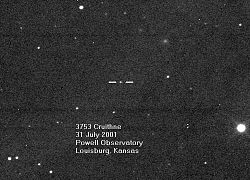(3753) Cruithne
(3753) Cruithne er en nærjords-asteroide af Atentypen. Den bliver sommetider kaldt for Jordens Anden Måne. Dette er dog ukorrekt, eftersom 3753 Cruithne ikke er en af Jordens naturlige satellitter. Men Cruithne har status af at være kvasisatellit til Jorden.[1]
Opdagelse
(3753) Cruithne blev opdaget 10. oktober 1986 af Duncan Waldron på et fotografi, taget med UK Schmidt Telescope på Siding Spring Observatory, Coonabarabran, Australien.[2]
Asteroiden fik sit navn efter Cruithnefolket (også kendt som priteni'erne), som var bosat i nutidens Skotland fra år 800 f.Kr., til år 1000; navnet refererer helt specifikt til deres legendariske første leder, som også bar navnet Cruithne.
Referencer
- ^ 25. juni 2015, videnskab.dk: Jordens anden 'måne' kan afsløre solsystemets mysterier Arkiveret 3. august 2020 hos Wayback Machine Citat: "...Så sent som i 1997 opdagede vi, at et andet himmellegeme, 3753 Cruithne, er det, som kaldes for en kvasi-satellit til Jorden..."
- ^ "Near-Earth Asteroid 3753 Cruithne Frequently Asked Questions". astro.uwo.ca. 6. juni 2018. Arkiveret fra originalen 4. november 2018. Hentet 31. oktober 2018.
Eksterne henvisninger
- webarchive backup, bogwebs.systime.dk: AsteroiderArkiveret 11. oktober 2004 hos Wayback Machine
| ||||||||||||||||||||||||||||||
| Spire Denne artikel om astronomi er en spire som bør udbygges. Du er velkommen til at hjælpe Wikipedia ved at udvide den. |
Medier brugt på denne side
Forfatter/Opretter: User:Jecowa, Licens: CC BY-SA 3.0
The orbits of Cruithne and Earth over the course of a year (from September 2007 to August 2008). Cruithne's location is indicated by the red box as it is too small to be seen at this distance. Earth is the white dot moving along the blue circle. The pale yellow circle in the centre is our Sun.
The blue circle represents the path of Earth as it revolves counter-clockwise around the sun. The "camera" revolves with Earth, so Earth appears to not be moving.
The red path represents the path that Cruithne takes as it revolves around the sun. Since the camera is rotating with Earth, Cruithne appears to move along a bean-shaped path. This illusion is known as a Horseshoe orbit.Forfatter/Opretter: Derivative work: User:Jecowa, Licens: CC BY-SA 3.0
The orbits of Cruithne and Earth over the course of a year (from September 2007 to August 2008). Cruithne's location is indicated by the red box as it is too small to be seen at this distance. Earth is the white dot moving along the blue circle. The yellow circle in the centre is our Sun.






